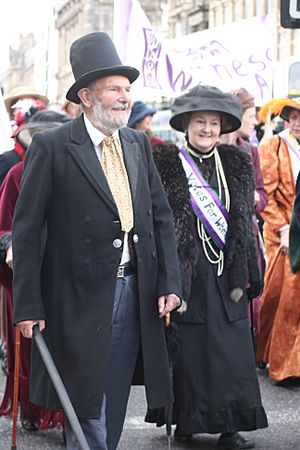Gude Cause 1909 and 2009 facts for kids
Gude Cause was a special project in Edinburgh, Scotland. It was all about celebrating the amazing work of Scottish women who fought for the right to vote, also known as the suffrage movement. This project inspired over 60 events across Scotland between 2007 and 2009.
The main goals of Gude Cause were to remember the women who campaigned for votes, celebrate what women had achieved in the 100 years since a big march in Edinburgh in 1909, and encourage women to get involved in politics today.
The project ended with a huge re-enactment of the 1909 march on October 10, 2009. Volunteers, historians, and community workers organized it. The event successfully brought the spirit of the original march back to life. It also helped people think about challenges women still face around the world, like ensuring equal pay.
Thousands of people from groups all over Scotland got ready for the big day. They made colourful banners, learned old songs, and talked about women's struggles from the past and present.
The crowd on the day included women, men, and children of all ages and backgrounds. There were students, activists, sports teams, political groups, and people from different faiths and jobs. Everyone came together to support women's rights, social justice, and a healthy environment.
Just like the original march a century before, the Gude Cause Procession in 2009 was led by a single woman playing the bagpipes. Her name was Pipe Major Louise Marshall Millington. A band called the Forth Bridges Accordion Band also played. Two mounted policewomen rode horses, just like women in the 1909 parade. Groups of drummers and singers led different parts of the procession, showing women's past, present, and future in Scotland.
Contents
Why Gude Cause Started
In 2007, before a big election in Scotland, studies showed that many women, especially young women, weren't planning to vote. It seemed they felt disconnected from politics. However, the same studies showed that women still cared deeply about important issues affecting people in Scotland and worldwide.
Research also found that women often had different opinions from men on many topics, like wars or nuclear weapons. This meant that if women's voices weren't heard enough in politics, government decisions might not fully consider everyone's needs.
In April 2007, the Edinburgh Peace & Justice Centre organized a smaller march to encourage women to get involved in politics again and to think about using their vote. Hundreds of women joined, walking through Edinburgh and singing songs. This event showed that women working together could plan an even bigger campaign.
The idea was to remember the brave women who campaigned for the right to vote for about 60 years, from 1867 to 1928. A very important event for this movement in Scotland was a large march through Edinburgh on October 9, 1909. So, it was decided to re-enact this march exactly one hundred years later, in 2009.
One of the many banners from the 1909 march said, "A Gude Cause Maks a Strong Arm" (meaning "A good cause makes a strong effort"). The organizers felt this message was still true in 2009, so they named their project "Gude Cause."
The project's goals were to remember the 1909 march and the important role of Scottish women in the suffrage movement. They also wanted to encourage Scottish women to get involved in politics at all levels. Another aim was to celebrate all the progress women had made over the last hundred years. Finally, they wanted to highlight the challenges women still faced, like lower pay and other inequalities.
The Gude Cause project officially began in October 2008 at the Scottish Parliament.
The 1909 Women's March
The 1909 Edinburgh march, which inspired Gude Cause, happened during a time of strong political feelings in Scotland. Women fighting for the vote, called suffragettes, used local elections to spread their message. Some were even arrested and went to prison, with some refusing to eat. Others campaigned tirelessly across the country, writing meeting details on pavements and facing angry crowds.
The 1909 march was organized by the Women's Social and Political Union (WSPU). They called it "The Great Procession and Women's Demonstration," with the theme "What women have done and can and will do." Flora Drummond, nicknamed 'the General,' led the march on horseback. A nine-year-old girl named Bessie Watson played the bagpipes.
Many women dressed as famous historical figures, and groups from all over joined the march along Princes Street. A huge number of local people came out to watch. Important leaders of the British suffragette movement, Emmeline Pankhurst and her daughter Christabel, gave speeches. Some of the first women to graduate from Edinburgh University also took part.
The Edinburgh Evening Dispatch newspaper wrote that the march showed "a strong group of determined women set on getting the vote." Many participants wore the WSPU colours of white, violet, and green. Others wore their university robes or work clothes. It was a powerful display of women's recent achievements and their hopes for future equality.
The newspaper also said that the march successfully showed thousands of people what the suffragettes wanted. It made it clear that a strong group of determined women were committed to getting the vote and would overcome any challenge.
The 2009 Gude Cause Event
On Saturday, October 10, 2009, about 5,000 people marched through Edinburgh in sunny weather. They came to remember the suffrage movement, celebrate women's achievements over the past 100 years, and encourage women to stay active in politics in Scotland. The message was clear: the suffragettes fought for votes for women, and now people wanted women to value and use those votes.
The main colours seen were violet, green, and white. Many people wore old-fashioned clothes from 1909, with sashes and banners demanding "Votes for Women." This looked just like the original march. There were also banners from groups involved in today's political and social causes.
Many different groups took part, including:
- Edinburgh Museums and Galleries
- Glasgow Museums
- University of the Third Age
- Soroptimists
- Women's Aid
- Glasgow Women's Library
- Scottish Youth Parliament
- Engender
- Equality Network
- Protest in Harmony (a choir)
- Workers Educational Association
- Women's Voluntary Sector Network
- Women @ Work
- Women in Black
- Women's History Scotland
- Women Artists Scotland
- Women's Engineering Society
- HIV Solidarity
- Environmental Groups
- Political Parties
- Trade Unions
- Citadel Arts Group, Leith, Edinburgh
- Africa Centre, Scotland
- University staff and students
- Youth groups and schools
- Scottish Women's Rural Institutes
The 2009 march started at Bruntsfield Links and followed a route through the city, ending at Calton Hill. The original route had to be changed because of tram construction work, so it couldn't go along Princes Street.
The procession paused on the High Street, where Jenny Dawe, the leader of the City of Edinburgh Council, spoke. She talked about the history of women's fight for recognition in Edinburgh. On behalf of the Council, Jenny gave the Gude Cause Committee a special banner made by museum volunteers. Several Members of the Scottish Parliament (MSPs) from different political parties joined the march.
Councillors also joined the procession and walked to Calton Hill. There, Fiona Hyslop MSP, the Minister for Education, spoke for the Scottish Government. Cathy Peattie MSP sang 'Bread and Roses', and Janet Fenton spoke about the goals and activities of the Gude Cause movement.
Gude Cause Projects and Support
Gude Cause built a network of women's groups to share information and work together. Over 100 organizations gave practical help and money. The Gude Cause committee worked closely with several key groups:
- The Workers' Educational Association (WEA) held classes across Scotland. These classes taught people about historical research, how to make banners and jewellery, and even playwriting. The Citadel Arts Group worked with the WEA to create a play called What Women Want, which was performed at the Edinburgh Festival Fringe. A film based on this play was also made.
- The STUC Women's Committee gave both practical help and money.
- The Educational Institute of Scotland created learning materials about women's suffrage. Their Edinburgh branch also ran a competition for schools.
- The Museum of Edinburgh held an exhibition called 'Votes for Women, the Women's Suffrage Movement in Edinburgh'. This exhibition included stories about women compiled by members of Women's History Scotland. A key item in the exhibition was the original "Votes for Women" sash worn in 1909 by nine-year-old piper Bessie Watson. This sash was even chosen as one of 100 important objects for a British Museum/BBC project.
- Women's History Scotland members also organized an event at a cinema and gave many talks.
Other projects by Gude Cause included:
- Contributing to the Festival of Politics at the Scottish Parliament.
- Workshops for making banners at places like the Glasgow Women's Library.
- A quilting project, where one quilt was later shown at the Scottish Parliament.
- Plays and concerts.
- Singing workshops.
- Publishing a timeline of Women's Suffrage over 100 years.
- Showing films about women's history.
- Publishing a songbook called "The Right to Vote an' a' that: a Hundred years of Scottish Women Singing."
- Creating a 'toolkit' for community and school groups to study women's suffrage history.
Gude Cause Media Project
One special project from Gude Cause is still continuing today. The Gude Cause Media Project collects photos and videos from the 2009 event. It also includes videos about Scottish women's history and the suffrage movement in Scotland.
The photos and videos are stored on Scran, an online resource for schools, colleges, libraries, and the public. Scran is part of RCAHMS, which is the Royal Commission on the Ancient and Historical Monuments of Scotland.
There is also a Gude Cause Group on Flickr where many of these images can be found.





